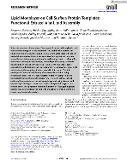Lipid Monolayer on Cell Surface Protein Templates Functional Extracellular Lipid Assembly

Autor
Dwivedi, Anupma
Mazumder, Anisha
Peterlik, Herwig
Maixner, Jaroslav
Datum vydání
2024Publikováno v
SmallRočník / Číslo vydání
20 (26)ISBN / ISSN
ISSN: 1613-6810ISBN / ISSN
eISSN: 1613-6829Metadata
Zobrazit celý záznamTato publikace má vydavatelskou verzi s DOI 10.1002/smll.202307793
Abstrakt
When the ancestors of men moved from aquatic habitats to the drylands, their evolutionary strategy to restrict water loss is to seal the skin surface with lipids. It is unknown how these rigid ceramide-dominated lipids with densely packed chains squeeze through narrow extracellular spaces and how they assemble into their complex multilamellar architecture. Here it is shown that the human corneocyte lipid envelope, a monolayer of ultralong covalently bound lipids on the cell surface protein, templates the functional barrier assembly by partly fluidizing and rearranging the free extracellular lipids in its vicinity during the sculpting of a functional skin lipid barrier. The lipid envelope also maintains the fluidity of the extracellular lipids during mechanical stress. This local lipid fluidization does not compromise the permeability barrier. The results provide new testable hypotheses about epidermal homeostasis and the pathophysiology underlying diseases with impaired lipid binding to corneocytes, such as congenital ichthyosis. In a broader sense, this lipoprotein-mediated fluidization of rigid (sphingo)lipid patches may also be relevant to lipid rafts and cellular signaling events and inspire new functional materials.
Klíčová slova
barrier, lipid assembly, membrane remodeling, permeability, template
Trvalý odkaz
https://hdl.handle.net/20.500.14178/2702Licence
Licence pro užití plného textu výsledku: Creative Commons Uveďte původ-Neužívejte dílo komerčně 4.0 International







